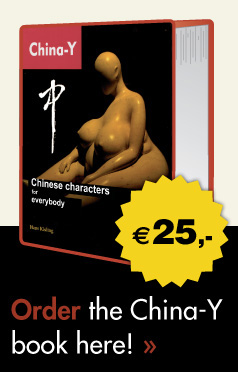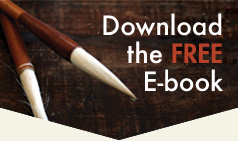The Structure
The Structure
The core of China-Y is the main body of 675 character pages. Each page has the same layout as explained in the examples.
These are introduced by auxiliary pages with prefaces by leading sinologists, explanatory notes, references and the manual of the book.
China-Y closes with a list of contributors, short biographies of the main participants, and a large index of graphs, keywords and names.
In this volume
- 214 basic elements (radicals)
- ± 100 auxiliary Pu-signs
- ± 350 attractive or useful combinations of elements
Every page deals with one character or part of a character.
In other words:
The graphical theme of the page which is summed up in a keyword (at the bottom), is brought out in an etymology, an illustration and an addition or aid in the form of a poetic or prosaic paragraph.
Several elements are mobilized to tempt the reader and student to contemplate an explanation or the history of the character.
The possibilities for extending the page contents are legion. This is gladly left in the hands of the resourcefulness of the reader or teacher.
From left to right:
The Pu-visualization: rendering of the, or a certain etymology.
The seal character from the dictionary Shuo Wen (about 100 AD) which is the basis of modern script.
The classical, complicated form, used outside the PRC.
Modern or abbreviated form of the character (if existing).
Most characters have a long, complicated and turbulent history behind them. Our knowledge about them is like ‘Swiss cheese’. Because of political developments, preferences, cross pollination, style changes, confused sounds it is very hard to reconstruct and feeds many a hefty debate.
The author has limited himself to depicting a certain etymology according to the views of a certain author and stays clear of the hornets nest. His aim is just to give the amateur or enthusiast a feeling for the immense wealth of life reflected in the characters. So Pu is a reconstruction, or a didactical visualization and standardisation of an opinion.
2. The meaning
A character often has many meanings, just like some English words. Look at the word ‘bank’ in the OED. For reasons of clarity we have chosen one, sometimes two basic meanings in the vernacular. When making choices I have considered popular dictionaries, vocabularies, frequency lists and above all the entries in the superb ‘Diccionario Español de la Lengua China’ by four Spanish Jesuits.
For detailed information on the meaning we refer to the popular dictionaries. If the meaning has faded and is only relevant for the construction of a composite character, this is marked: ‘part of a character’.
3. The bridge
For numerous reasons the imagery enclosed in the character is often not identical with (or sometimes even related to) the current meaning. One of the reasons is that writing, sound and meaning develop divergingly. To bridge this chasm a ‘bridge’ is inserted when needed, often between parentheses (doubtful, supposed or fantasised).
So the order is: formula (paradigm)… bridge… meaning.
Preferably of course has been drawn from the signification material of the character, though the reader has to be aware that the evolution of the meaning has not necessarily followed that path.
4. The formula, the paradigm
The formula is applied to characters that are constructed from multiple elements. These refer to the main words at the bottom. It looks like a jigsaw puzzle. Mind you: this is not mathematical and/or logical but associative, understandable. We are dealing with a living language you know.
Following the Japanese example I have given every element its own name, which forms the largest common denominator of most of the meanings that are attached to it in all sorts of combinations.
See ‘The Bridge’.
If an element is used because of its meaning or associated meaning, the letter r (radical, meaning carrier, semantic element) is added with a standard number.
If an element is used because of the sound, the letter f is added + a number from the list of the etymologist Wieger.
A very limited list of fon characters is included in the final pages.
5. The decorative text
A text is added to decorate the themes and as a step towards the etymology.
This contains an improvisation of the theme on the page. The text is not meant to clarify the character history, but merely put in for good measure. This can broaden your field of vision!
A part of the arsenal of texts is borrowed from world literature. Many are from the Bible which according to me is the largest treasure trove of textual imagery that there is.
Others have been especially prepared by a team of writers from home and abroad. See the list at the back.
6. The keyword
The book is alphabetically ordered following the keyword. This keyword systematically refers to the images from which the character is built. If it consists of multiple elements it still refers to the conclusion of the construction formula, bottom left (the so called paradigm).
ATTENTION! The main word emphatically does not refer to the present meaning of the character. This framework has been chosen in order to be able to build and puzzle with the characters or parts that occur in the book.
Example: the page ‘pregnant’.
person + circle (womb) + embryo + legs = pregnant
You will find the history of the separate parts under the main words ‘person’, ’embryo’ and ‘legs’. ‘Womb’ (with asterisk) can only be found in the list with abbreviations and symbols. The sum of these elements, the concept ‘pregnant’, is the keyword and search criteria for the whole character. But the present meaning is ‘body’.
Mind you: China-Y is a study dictionary for the construction of characters and not an explanatory dictionary for the language. Apart from that: we will often come across a discrepancy between the meaning of a pictogram and the present meaning.
7. Additional information
A description of the artwork, often giving the title, always the name of the artist, and the technique used. On many pages, extra etymological notes are added here, weaving connections throughout the entire book.
8. Illustration
A coloured illustration is added in order to illuminate the visualization of the etymology (the so called Pu-character) which confers an important extra didactical value to the book. An extensive group of artists have worked on this: full professionals, semiprofessionals, amateurs, mentally handicapped, children, who have used all sorts of techniques. This also makes the book colourful and lively in a pictural sense.
Because the ‘primitive character’ has universal value no typical Chinese prints have been made but there is a more or less free, playful improvisation of the etymology.
In short:
- alphabetical order of the graphics
- etymological steps from primitive picture to modern character
- auxiliary graphic language system (Pu)
- color illustration around the original form, done by a large group of artists of all levels and ages
- verbal improvisation on the graphic theme as an extra dimension
- formula of the components of each character
- essential meaning (based on a unique Jesuit source)
- Chinese pronunciation
These elements are meant to tempt the reserved westerner to overcome his natural resistance to the apparent complexity and invincibility of oriental characters.
This book really opens up a marvelous and fascinating world of images, symbols and associations.



 sending...
sending...